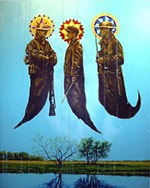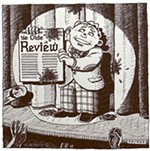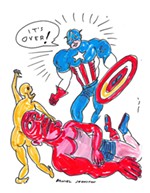‘All Dressed in White’
Each of the seven video / multimedia works in Women & Their Work's "All Dressed in White" grapples with what the institution of marriage means or should mean in the life of a contemporary woman
Reviewed by Robert Faires, Fri., Aug. 18, 2006

"All Dressed in White"
Women & Their Work Gallery, through Sept. 9
You can see the appeal: the ceremony of union, the ritual binding you with your perfect mate for life. The presence of those dearest to you. The slow procession, all their eyes on you. The music. The flowers. And, not least, that gown – as elaborate as one for a princess and all white, signifying purity. That blend of pageantry and romance is as close as most ever get to a fairy-tale moment – and, of course, it's meant to serve as the setup for one's own fairy-tale ending, with bride and groom living "happily ever after."
It doesn't matter that our world doesn't feel much like one in a fairy tale. We know the economic and societal pressures on married couples, the incidence of spousal abuse, the divorce rates. But despite all that – or maybe because of it – the image of the traditional bride still pulls at us, still beckons to us alluringly down the aisle. So, with all the shifts in women's roles and cultural attitudes and demographics, do we stay or do we go?
That question seems to lie at the heart of Women & Their Work's "All Dressed in White." Each of its seven video and multimedia works grapples with what the institution of marriage means or should mean in the life of a contemporary woman. While curator Diane Zander Mason includes just seven works, her exhibit provides surprising breadth in considering matrimony across lines of age, race, culture, creed, and sexual orientation. We drop into a cross-cultural firestorm about the decline in marriage among African-Americans (sparked by The Washington Post feature "Marriage Is for White People"), take in competing views of marriage from a young boy and a young girl, witness a lesbian's obsession with wedding her partner of 25 years, listen to fundamentalist Christian wives defend the principle of submission to their husbands, see a 30-year-old Anglo newlywed wrestle with the prospect of motherhood, and hear a Peruvian wife and mother describe the end of her marriage after 20 years.
Now, getting this range of perspectives requires patience. To see all seven works takes about an hour. However, since you can't control when the works start, sometimes you have to wait for one to finish and loop back to the beginning, which, with some works running more than 10 minutes each, can add to your time in the gallery. And as most works have only one set of headphones for listening to the audio, other viewers may lead to additional delays. That said, giving yourself over to the works without regard to time can open a refreshingly contemplative space for absorbing these works. Zander Mason's own contribution, Submit, weds a soundtrack of women describing their experiences of Christian submission to a visual of his-and-her marriage vows projected a word at a time; the slow unfolding of this pledge, with each word landing like a droplet in a pool, lets you weigh fully the meaning and import of every word, of the promises being made. Plus, the longer you spend in the exhibition, the easier you can hear the common feelings among its voices across those divides of history and geography: the desire and the uncertainty. You want to be with someone, but is this the one? Will I still be who I am? What do I give up? What do I gain? Do I stay or do I go?
Don't expect to find many answers here, however. If "All Dressed in White" makes any definitive statement about marriage and women today, it's that our culture is still figuring it out. In Julie Hanus' cheery film Fifty Brides on a Fire Escape, a host of white-gowned young women file out of a second-story doorway and down a stairway outside of what looks to be a church. It's easy to assume that they're all headed to a wedding. And yet, even as these brides descend, as if toward some supersized, 50-ring ceremony, superimposed on them are images of the same women ascending the fire escape, ghostly figures seeming to walk away from that fairy-tale moment. Are these their imagined selves, runaway brides barely escaping a lifetime of marital captivity? Once the last bride disappears through a downstairs door, the brides file out the door and back up the fire escape, while superimposed images of them coming down the stairs float past. Since these brides are so patently divorced, excuse the pun, from any grooms, the film suggests the ambivalence of women toward marriage, at once drawn to it and moving away from it. That image may stand for this show's overall attitude: Here comes the bride; there goes the bride.










